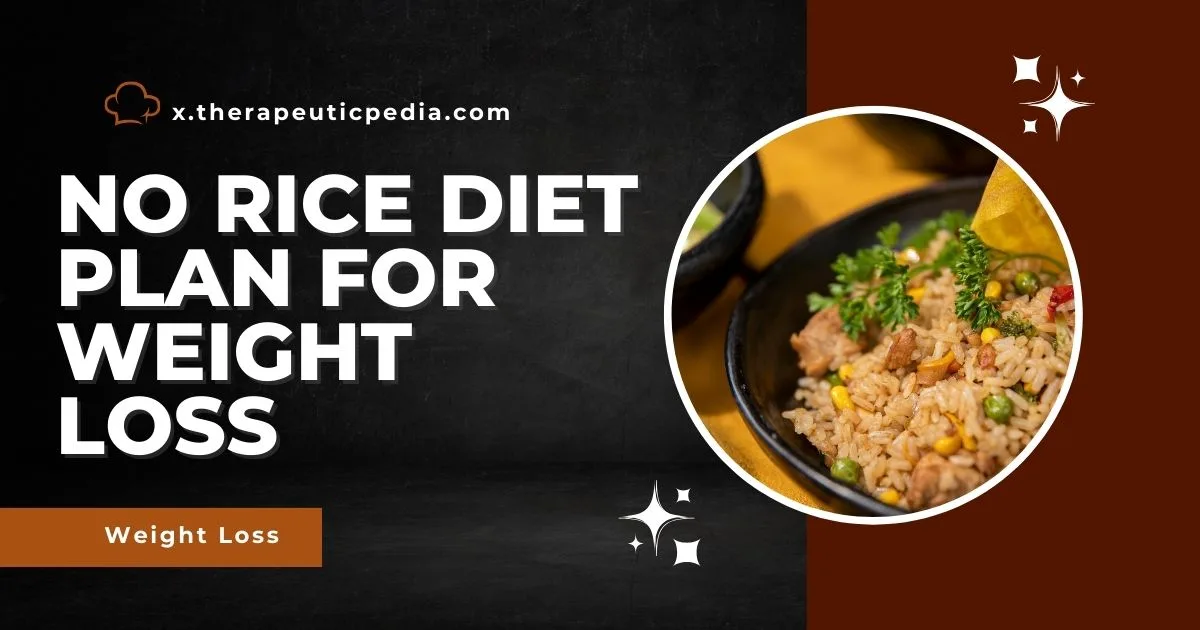No Rice Diet Plan:
To effectively reduce weight in a healthy manner, many individuals incorporate various dietary plans and strategies into their meals. One such plan that is currently gaining popularity is the “No Rice Diet Plan for Weight Loss.” Rice is a staple food in many cultures, but when it comes to weight loss, it is often excluded from diets because it contains significant amounts of carbohydrates and calories. Eliminating rice from the diet provides beneficial and effective alternatives for weight loss.
Understanding the No Rice Diet Plan For Weight loss:
The No Rice Diet Plan is a dietary perspective in which rice is removed from one’s meals to reduce the amount of carbohydrates. Carbohydrates, particularly refined carbohydrates like white rice, are known to work to increase blood sugar levels, if consumed in excess and not balanced with other nutrients. By removing rice, the goal of individuals is to promote a diet low in carbohydrates so that weight loss can be expedited.
How Carbohydrate cause weight gain?
Weight loss can be achieved by reducing calorie intake and adhering to a dietary plan that promotes weight loss. As rice is a carbohydrate source that can contribute to weight gain if consumed excessively, while weight loss can occur if consumed fewer calories.
Benefits of the No Rice Diet Plan
Reduced Caloric Intake: Rice, especially when consumed in large portions, can contribute significantly to one’s daily calorie intake. By eliminating rice, individuals can lower their overall calorie consumption, which is crucial for weight loss.
Lower Glycemic Index: Rice, especially white rice, has a high glycemic index, meaning it can cause rapid spikes in blood sugar levels. Choosing lower glycemic index foods in place of rice can help stabilize blood sugar levels and prevent cravings.
Increased Nutrient Diversity: By excluding rice, individuals are encouraged to explore a wider variety of foods, including vegetables, lean proteins, and healthy fats, leading to a more balanced and nutrient-rich diet.
Enhanced Weight Loss: For some individuals, reducing carbohydrate intake by eliminating rice may lead to more efficient weight loss, especially when combined with regular exercise and other healthy lifestyle habits.
How much weight can we lose without eating rice for 1 month?
It’s difficult to say how much weight you can lose by not eating rice for a month, as it depends on various factors such as your overall diet, exercise routine, metabolism, initial weight, and individual body composition.
On average, a serving of cooked rice (about 1/2 cup) contains approximately 100-150 calories. So, if you typically consume rice daily and eliminate it from your diet without compensating with other high-calorie foods, you can reduce your calorie intake, which may aid in weight loss.
Considerations When Following the No Rice Diet Plan:
The “No Rice Diet” is a dietary approach that restricts or eliminates rice consumption, focusing on nutrient balance and dietary alternatives. Rice is a significant source of carbohydrates, providing essential nutrients like B vitamins and minerals. To maintain nutrient balance, replace rice with other carbohydrate sources like quinoa, barley, oats, sweet potatoes, or whole grain bread and pasta. Be mindful of portion control and maintain a diverse diet. Monitor blood sugar levels and work with a healthcare professional if needed. Cultural considerations and incorporating other foods that promote satiety can help maintain enjoyment of meals. Weight loss may be possible, but outcomes depend on individual factors. Consider health conditions and lifestyle adaptations when removing rice from your diet.
- Nutrient Balance: While eliminating rice can reduce carbohydrate intake, it’s essential to ensure that one’s diet remains balanced and provides all essential nutrients. Incorporating a variety of whole grains, fruits, vegetables, and lean proteins is key to meeting nutritional needs.
- Individual Preferences and Cultural Considerations: Rice is a staple food in many cultures, and eliminating it from the diet may not be feasible or desirable for everyone. It’s important to respect individual preferences and cultural traditions when adopting any diet plan.
- Potential Short-Term Effects: Some individuals may experience initial discomfort or changes in bowel habits when drastically reducing carbohydrate intake. It’s essential to listen to your body and make gradual adjustments to your diet if needed.
- Long-Term Sustainability: While the No Rice Diet Plan may result in short-term weight loss, its long-term sustainability depends on individual preferences, lifestyle factors, and overall dietary habits. It’s crucial to choose a diet plan that is both effective and sustainable for the long term.
No Rice Meal Plan
Alternatives to Rice in the No Rice Diet Plan:
- Quinoa: It is a nutritious grain that you can incorporate into your diet instead of rice. It is a whole grain that can prove to be beneficial in providing fiber, protein, and essential vitamins and minerals.
- Cauliflower Rice: This is also a good alternative to rice that can mimic the texture of finely chopped cauliflower rice and work as a low-carb option for rice in various dishes.
- Sweet Potatoes: Sweet potatoes are a nutritious carbohydrate source, rich in fiber, vitamins, and minerals, which are considered a satisfying and nutritious alternative to rice.
- Barley: Barley is another whole grain option that can be used instead of rice during weight loss, providing fiber and nutrients to support satiety and overall health.
Note: You can incorporate all these grains into your diet if you do not want to eat rice during weight loss journey.
